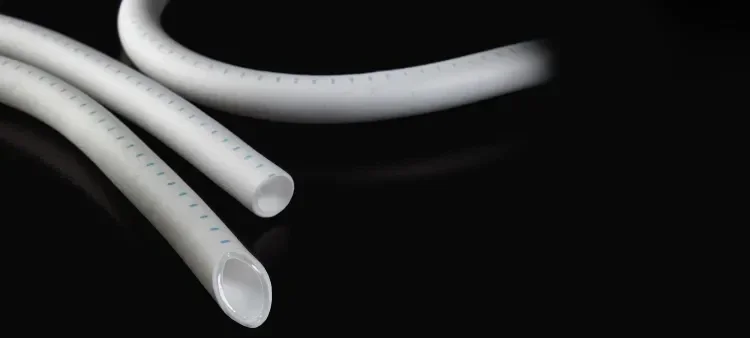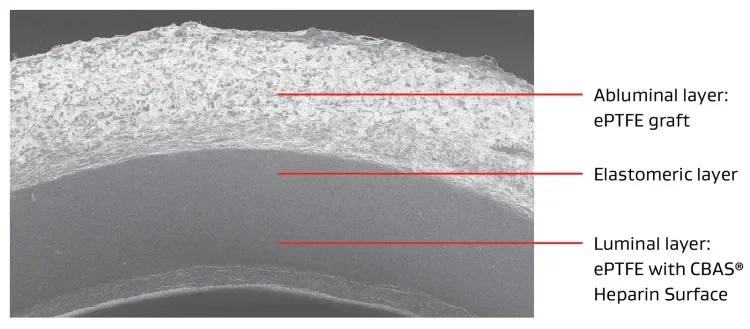
GORE® ACUSEAL Vascular Graft
From fistula-first to patient-first
For hemodialysis patients, a "fistula first" approach has long been the standard. But fistulas can fail, 20 to 60 percent of the time,1-5 subjecting patients to undue hardship and central venous catheter (CVC)-related risks.
That's one reason 2019 Kidney Disease Outcomes Quality Initiative (KDOQI) guidelines6 emphasize the need for a more individualized approach to access modality selection.
It is about achieving the "right access, in the right patient, at the right time, for the right reasons."
- KDOQI guidelines
When patients are at risk for fistula non-maturation, turn to the GORE® ACUSEAL Vascular Graft – the purpose-built choice for rapid and long-term access for the road ahead. It is ideal for patients who are already on a CVC, or those who need a new access and must achieve cannulation in under two weeks.
It allows for earlier removal or avoidance of a CVC and helps achieve hemodialysis success with minimized access-related procedures and complications ─ for more confidence at every step.



Designed with your patients in mind
Because dialysis access is personal
The tri-layer design of the GORE® ACUSEAL Vascular Graft is optimized for early cannulation and provides uncompromised handling.

- Purpose-built for immediate cannulation, designed with an elastomeric middle layer that serves as a low bleed barrier to cannulation needle holes.
- Flexible at curves without kinking.
The GORE® ACUSEAL Vascular Graft also features CBAS® Heparin Surface technology to resist thrombosis ─ a leading cause of AVG failure.11

* Compared with non-immediate cannulation AV grafts.
† Compared with standard non-heparin bonded ePTFE grafts.
- Allon M, Robbin ML. Increasing arteriovenous fistulas in hemodialysis patients: problems and solutions. Kidney International 2002;62(4):1109-1124.
- Allon M, Imrey PB, Cheung AK, et al; Hemodialysis Fistula Maturation (HFM) Study Group. Relationships between clinical processes and arteriovenous fistula cannulation and maturation: a multicenter prospective cohort study. American Journal of Kidney Diseases 2018;71(5):677-689.
- Dember LM, Beck GJ, Allon M, et al; Dialysis Access Consortium Study Group. Effect of Clopidogrel on early failure of arteriovenous fistulas for hemodialysis. A randomized controlled trial. Journal of the American Medical Association 2008;299(18):2164-2171.
- Allon M. Vascular access for hemodialysis patients: new data should guide decision making. Clinical Journal of the American Society of Nephrology 2019;14(6):954-961.
- Wish JB. Catheter last, fistula not-so-first. Journal of the American Society of Nephrology 2015;26(1):5-7.
- Lok CE, Huber TS, Lee T, et al; KDOQI Vascular Access Guideline Work Group. KDOQI Clinical Practice Guideline for Vascular Access: 2019 update. American Journal of Kidney Diseases 2020;75(4)Supplement 2:S1-S164.
- Marketrack: PriceTrack Database. Burlington, MA: Decision Resources Group; 2015 https://decisionresourcesgroup.com/. Accessed August 14, 2017.
- Aitken E, Thomson P, Bainbridge L, Kasthuri R, Mohr B, Kingsmore D. A randomized controlled trial and cost-effectiveness analysis of early cannulation arteriovenous grafts versus tunneled central venous catheters in patients requiring urgent vascular access for hemodialysis. Journal of Vascular Surgery 2017;65(3):766-774.
- Glickman M. Early cannulation graft: Acuseal. Journal of Vascular Access 2016;17 (Supplement 1):S72-S74.
- Mohr BA, Trovillion PJ. Economic value of preventing central venous catheter sepsis infections with early cannulation arteriovenous grafts (ECAVGS) compared to non-ecavgs. Presented at the ISPOR 20TH Annual International Meeting; May 16-20, 2015; Philadelphia, PA. Value in Health 2015;18(3):A42 PMD27.
- Roy-Chaudhury P, Kelly BS, Melhem M, et al. Vascular access in hemodialysis: issues, management, and emerging concepts. Clinical Cardiology. 2005;23:249-273.
- Shemesh D, Goldin I, Hijazi J, et al. A prospective randomized study of heparin-bonded graft (Propaten) versus standard graft in prosthetic arteriovenous access. Journal of Vascular Surgery 2015 Jul;62(1)115-22. doi:10.1016/j.jvs.2015.01.056. Epub 2015 Mar12. PMID: 25770987.
- Davidson I, Hackerman C, Kapadia A, Minhajuddib A. Heparin bonded hemodialysis e-PTFE graft result in 20% clot free survival benefit. Journal of Vascular Access 2009 Jul-Sep;10(3):153-6. doi: 10.1177/112972980901000303. PMID:19670166.
Featured resources
22589404-EN
